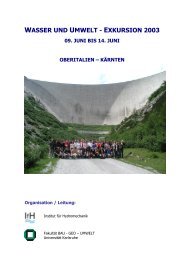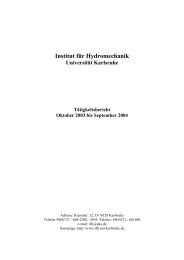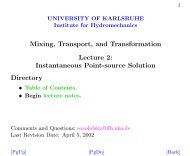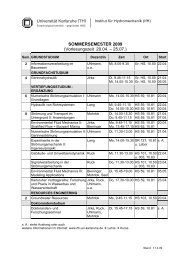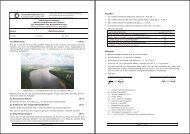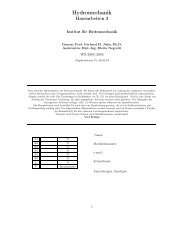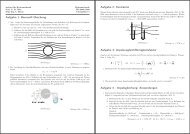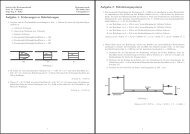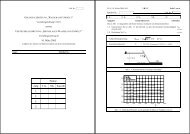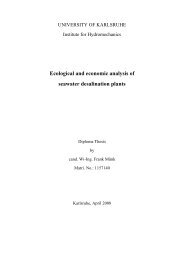user's manual for corhyd: an internal diffuser hydraulics model - IfH
user's manual for corhyd: an internal diffuser hydraulics model - IfH
user's manual for corhyd: an internal diffuser hydraulics model - IfH
You also want an ePaper? Increase the reach of your titles
YUMPU automatically turns print PDFs into web optimized ePapers that Google loves.
3.1.4 Automatic implementation of loss <strong>for</strong>mulations - additional losses<br />
CorHyd automatically applies the necessary local loss <strong>for</strong>mulations <strong>for</strong> the user given inputs.<br />
For special configurations, which need more detailed specifications of geometries additional<br />
input is necessary <strong>for</strong> the calculations.<br />
If <strong>for</strong> example the port is mounted perpendicular onto the riser, this local bending loss is not<br />
included but c<strong>an</strong> be added as a known loss. If a riser has more th<strong>an</strong> one port, it is assumed,<br />
that the discharge flowing through the riser with T-shape including this additional loss <strong>an</strong>d is<br />
distributed evenly among all ports (i.e. <strong>for</strong> two ports, both would have half the discharge).<br />
The <strong>for</strong>mulations <strong>for</strong> local losses applied in CorHyd assume reasonable high Reynolds<br />
numbers (above 10 4 ) <strong>an</strong>d reasonable geometrical dist<strong>an</strong>ce (above 3 times the diameter)<br />
between geometrical ch<strong>an</strong>ges to avoid interaction of losses. Modifications of the listed<br />
<strong>for</strong>mulations c<strong>an</strong> be found in Idelchik (1986) <strong>for</strong> special geometries <strong>an</strong>d some limited r<strong>an</strong>ges<br />
of Reynolds numbers, but have not been implemented in CorHyd.<br />
3.2 Governing Equations<br />
The governing equations are continuity equations at each flow division <strong>an</strong>d the work-energy<br />
equation along pipe segments with const<strong>an</strong>t or known flowrate (Fig. 13). Required input data<br />
are the geometry of the discharge structure with sets of <strong>diffuser</strong> pipe segment locations x,<br />
y, z, riser/port segment geometries (i.e. cross-sections A, riser/port number <strong>an</strong>d allocation, <strong>an</strong>d<br />
roughness k s ). Pipe lengths L <strong>an</strong>d pipe joint configurations are calculated automatically out of<br />
these parameters. Used indices are ‘d’ <strong>for</strong> <strong>diffuser</strong> pipe sections, ‘r’ <strong>for</strong> riser sections, ‘p’ <strong>for</strong><br />
port sections <strong>an</strong>d ‘j’ <strong>for</strong> jet properties at the vena contracta of the discharging jet. The<br />
ambient is described by its density ρ a <strong>an</strong>d the average water level elevation H resulting in<br />
different external hydrostatic pressures p a,i at the vertical location of the jet centreline at the<br />
vena contracta at each i position along the <strong>diffuser</strong> pipe, where risers or ports are attached.<br />
The effluent is described by its fluid density ρ e <strong>an</strong>d either the total flow rate Q or the total<br />
available water level at the headworks (total head H t ).<br />
Additional input fields allow to specify more detailed in<strong>for</strong>mation on local losses, T- or Y-<br />
shaped <strong>diffuser</strong> configurations or the denomination of clogged or temporary closed ports.<br />
Implemented local losses are those from chapter 2.4. Here<strong>for</strong>e ζ p,i,j , ζ r,i,j , ζ d,i,j denote the local<br />
loss coefficients <strong>for</strong> each j-component of the total number n p,i of losses in a port, n r,i in a riser<br />
or n d,i in the <strong>diffuser</strong> pipe with pipe cross-sectional areas A p,i,j , A r,i,j <strong>an</strong>d A d,i,j respectively. λ p,i,j<br />
, λ r,i,j <strong>an</strong>d λ d,i,j denote the friction coefficients <strong>for</strong> related pipe components with length L p,i,j ,<br />
L r,i,j <strong>an</strong>d L d,i,j diameter D p,i,j , D r,i,j D d,i,j equivalent pipe roughness k sp,i,j , k sr,i,j , k sd,i,j respectively<br />
<strong>for</strong> either port, riser or <strong>diffuser</strong> component j. For each port or riser, the local <strong>an</strong>d friction loss<br />
coefficients are determined iteratively, since they depend on the discharge.<br />
Institut für Hydromech<strong>an</strong>ik, Universität Karlsruhe 28



